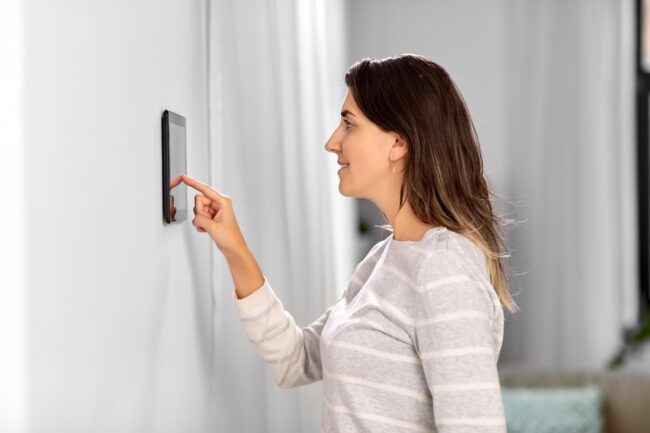
Smart technology is changing the way we live, making our homes more efficient, comfortable, and secure. Whether you’re looking to save time, cut energy costs, or simply enjoy more convenience, adding smart tech to your home is a smart move.
From voice-controlled lights to smart thermostats and security systems, the options are growing fast and becoming easier to use. Even small upgrades can make a big difference in your daily routine.
In this blog, we’ll share 8 smart technology ideas that can improve how your home works and how you feel living in it. Simple, practical, and worth the investment.
1. The Smart Home Revolution: Understanding Modern Home Technology
Before diving into specific solutions, it’s important to understand the foundation of what makes a modern smart home work. The integration of various technologies creates an ecosystem where devices communicate and work together to enhance your daily life.
Key Components of an Integrated Smart Home System
A smart home runs on a central hub or controller that connects and manages all your devices. These hubs use Wi-Fi, Bluetooth, Zigbee, or Z-Wave to communicate. Many people begin with smart speakers like Amazon Echo or Google Nest for voice control. Mobile apps add convenience by offering remote access. The real value comes when everything works together, enabling automated routines that adjust to your lifestyle with little effort.
Current Smart Home Technology Trends in 2025
This year, artificial intelligence in home systems is more advanced, learning your habits for personalized suggestions, while smart technology emphasizes sustainability through accurate energy use and reduced environmental impact.
eSIM technology is revolutionizing how smart devices connect to networks, eliminating the need for physical SIM cards and enabling seamless connectivity for everything from security cameras to smart thermostats. Understanding what is eSIM and how it works makes it clear why this innovation is simplifying the process of adding new devices to your home network like never before. It’s a forward-thinking solution that supports smarter, more connected living.
2. Smart Security Systems: Protecting Your Home with Advanced Technology
Modern home technology trends have transformed security from simple alarm systems to comprehensive protection networks that monitor, alert, and even deter potential threats.
Comprehensive Smart Surveillance Solutions
Today’s smart cameras go beyond simple video recording, using AI to tell the difference between people, animals, and vehicles. This reduces false alerts and ensures real threats are flagged. With cloud and local storage options, you can choose what suits your privacy needs.
Features like night vision, weatherproofing, and wide-angle lenses provide full coverage. They also connect with other smart devices, enabling automatic actions like lighting when motion is detected.
Smart Locks and Access Control
Keyless entry systems represent a major upgrade from traditional locks, offering convenience without sacrificing security. Biometric options like fingerprint readers provide personalized access, while PIN codes can be created and deleted as needed for temporary visitors.
Remote access management allows you to control who enters your home even when you’re miles away. Many systems log activity and send real-time alerts, keeping you informed about who’s coming and going at all times.
3. Smart Energy Management: Reducing Costs While Saving the Planet
Implementing home automation ideas for energy management creates both environmental and financial benefits through intelligent resource usage.
Intelligent Climate Control Systems
Smart thermostats have evolved beyond simple scheduling to incorporate learning capabilities that understand your preferences and occupancy patterns. These devices optimize temperature based on when you’re home, helping you save energy without sacrificing comfort.
Zone-based temperature management allows different areas of your home to maintain independent settings, preventing energy waste in rarely used spaces. Many systems also integrate with weather forecasts to anticipate and adjust for changing conditions.
Smart Lighting Solutions
Motion-activated lighting ensures spaces are illuminated only when needed, while schedule-based systems can mimic occupancy patterns when you’re away for security purposes. Smart home technology for lighting also allows for color and brightness adjustments that can transform your home’s atmosphere with a simple voice command.
Energy consumption monitoring helps identify and eliminate waste, while integration with natural light sensors allows your system to balance artificial lighting with available daylight for maximum efficiency.
4. Smart Kitchen and Appliance Innovations
The heart of many homes is becoming increasingly intelligent with technology ideas for homeowners that streamline cooking, food storage, and resource management.
Connected Kitchen Appliances
Smart refrigerators can track inventory, suggest recipes based on available ingredients, and even create shopping lists for items you’re running low on. Voice-controlled ovens and cooktops allow hands-free operation while cooking, enhancing both convenience and safety.
Remote monitoring lets you check if you’ve left appliances running, while intelligent cooking features can perfectly prepare meals according to precise specifications.
Water and Waste Management Technology
Leak detection systems can identify and alert you to potential water issues before they cause significant damage. Usage monitoring helps identify inefficiencies, while some systems can automatically shut off water flow when problems are detected.
Smart waste management solutions can help sort recyclables, while voice-activated faucets reduce both water waste and the spread of germs in your kitchen.
5. Entertainment and Comfort Technology
IoT home devices have transformed how we experience entertainment and relaxation in our homes, creating immersive and personalized experiences.
Immersive Home Entertainment Systems
Multi-room audio allows synchronized or independent music throughout your home, controlled through voice commands or smartphone apps. Smart TVs integrate with streaming services and can be part of automated routines that dim lights and adjust room temperature for the perfect movie night.
Voice control eliminates the frustration of hunting for remote controls, while scene settings can transform your space with a single command.
Smart Sleep and Relaxation Technology
Sleep tracking devices monitor your rest patterns and provide insights for improvement, while smart beds can adjust firmness and position based on your preferences. Ambient noise generators and smart lighting can create the perfect environment for falling asleep and waking naturally.
These smart home innovations work together to optimize your sleep environment, potentially improving your health and daily performance.
6. Health and Wellness Smart Home Innovations
Creating a healthier living environment is another major advantage of smart home technology, with devices that monitor and improve your home’s impact on your wellbeing.
Air Quality Monitoring and Purification
Real-time sensors can detect pollutants, allergens, and VOCs, triggering automated purification systems when levels exceed healthy thresholds. Smart humidity control prevents mold growth while maintaining comfortable breathing conditions.
These systems can work silently in the background, creating a healthier environment without requiring constant attention or adjustment.
Smart Fitness and Health Monitoring
Connected exercise equipment can track your workouts, provide guidance, and even integrate with virtual coaching services. Health metric monitoring extends beyond activity to track vital signs and wellness indicators over time.
Many of these IoT home devices can share data with your smartphone’s health apps, creating a comprehensive picture of your physical wellbeing.
7. Smart Home for Remote Work and Productivity
The rise of remote work has created new opportunities for home automation ideas that enhance productivity and create more effective work environments.
Creating an Efficient Home Office Environment
Automated lighting and climate settings can adjust based on your work schedule, creating ideal conditions for focus and comfort. Smart scheduling systems can help manage your time, while noise-cancellation technology minimizes distractions.
Ergonomic monitoring tools can even remind you to adjust your posture or take breaks, promoting healthier work habits throughout the day.
Connectivity Solutions Beyond Traditional WiFi
Mesh network systems provide consistent coverage throughout larger homes, eliminating dead zones that can interrupt your work. Understanding what is eSIM technology helps you maintain backup connectivity for critical devices, ensuring you stay connected even during primary network outages.
Dedicated bandwidth management tools can prioritize work applications during important meetings or presentations, preventing household streaming or gaming from affecting your professional connectivity.
8. Implementation Guide: Building Your Smart Home Ecosystem
With so many options available, creating a cohesive smart home technology environment requires thoughtful planning and implementation.
Starting Small: Essential First Steps
Begin by identifying your priority areas – security, energy management, entertainment, or convenience. Many homeowners start with a smart speaker and compatible lighting as an affordable entry point.
Consider compatibility between devices to ensure your ecosystem can grow over time. While many systems offer DIY installation, complex integrations might benefit from a professional setup.
Scaling Your Smart Home Over Time
Creating a long-term roadmap helps you build a cohesive system rather than a collection of disconnected gadgets. Focus on devices that can communicate with each other through standard protocols to maximize integration possibilities.
Future-proofing your improved home technology investments means choosing systems with regular software updates and broad compatibility rather than closed ecosystems that might limit your options.
The Future of Smart Living
The rapid evolution of smart technology for home applications is just beginning, with increasingly intelligent systems that anticipate needs rather than simply responding to commands. As you implement these technologies, focus on creating a home that enhances your lifestyle rather than adding complexity.
By thoughtfully integrating these eight technology areas, you can create a living environment that’s more comfortable, efficient, secure, and enjoyable. The key isn’t adopting every new gadget but finding the smart solutions that truly improve your daily experience.
FAQs on Smart Technology Ideas
1. What are the basic smart home technologies?
A smart home allows homeowners to control appliances, thermostats, lights, and other devices remotely through an internet connection using a phone app or tablet. Smart homes can be set up with wireless or hardwired systems.
2. What is the future of smart home technology?
Future smart homes will be equipped with health monitoring devices that track vital signs, such as heart rate, blood pressure, and sleep patterns. These devices will provide valuable insights into a person’s health and alert them to potential issues before they become serious.
3. What are the three points for a smart home?
What you need to turn your regular home into a smart home are 1) a wifi connection, 2) smart home appliances (or smart home devices), and 3) a smart home system to connect, monitor, and control these devices.
